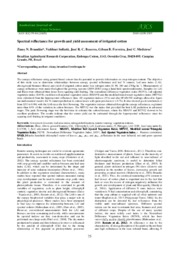Spectral reflectance for growth and yield assessment of irrigated cotton.
Spectral reflectance for growth and yield assessment of irrigated cotton.
Author(s): BRANDAO, Z. N.; SOFIATTI, V.; BEZERRA, J. R. C.; FERREIRA, G. B.; MEDEIROS, J. C.
Summary: The canopy reflectance using ground-based sensors has the potential to provide information on crop nitrogen content. The objective of this study was to determine relationships between canopy spectral reflectance and leaf N content, leaf area index (LAI), aboveground biomass (Biom) and yield of irrigated cotton under four nitrogen rates (0, 90, 180 and 270kg ha-1). Measurements of canopy reflectance were made throughout the growing seasons (2009-2010) using a hand-held spectroradiometer. Samples for LAI and Biom were obtained three times from squaring until fruiting. The normalized difference vegetation index (NDVI), soil adjusted vegetation index (SAVI), modified soil adjusted vegetation index (MSAVI) and the modified transformed vegetation index (MTVI2) were calculated from the hyperspectral reflectance data. All vegetation indexes (VIs) and also SPAD-502 readings allowed to figure out mathematical models for N content prediction in cotton leaves with great precision (r > 0.74). It also showed good correlations (r from 0.55 to 0.96) with the LAI since the first flowering. The vegetation indexes obtained through the canopy reflectance, explained more than 64% of the variation in cotton biomass. The MTVI2 was the index that provided the best LAI prediction in advanced stages. The peak flowering stage was the best time to estimate the cotton biomass, where the MSAVI and MTVI2 showed to be excellent predictors. The results indicate that the cotton yield can be estimated through the hyperspectral reflectance since the squaring until fruiting in irrigated conditions.
Publication year: 2015
Types of publication: Journal article
Unit: Embrapa Cotton
Observation
Some of Embrapa's publications are published as ePub files. To read them, use or download one of the following free software options to your computer or mobile device. Android: Google Play Books; IOS: iBooks; Windows and Linux: Calibre.
Access other publications
Access the Agricultural Research Database (BDPA) to consult Embrapa's full library collection and records.
Visit Embrapa Bookstore to purchase books and other publications sold by Embrapa.

